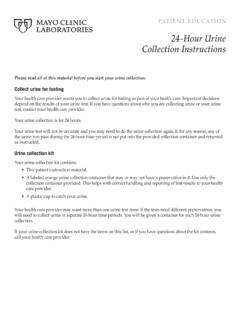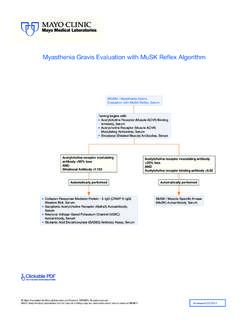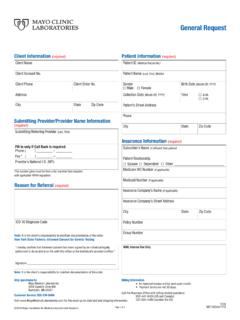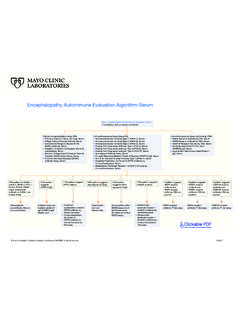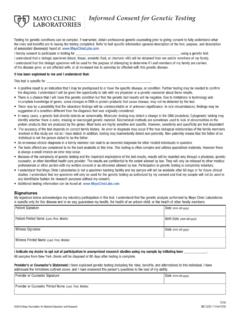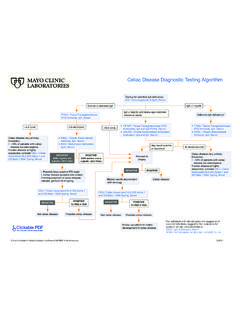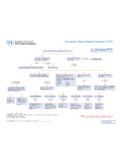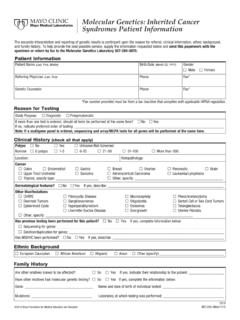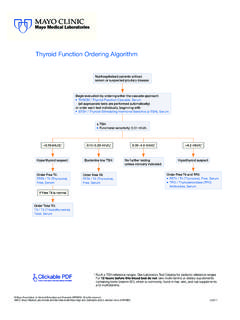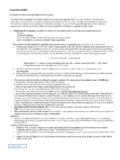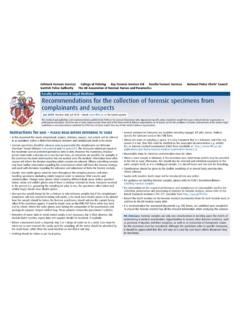Transcription of Trace Metals Analysis Specimen - Mayo Medical …
1 MC1235-233rev1018 Page 1 of 4 Trace Metals Analysis Specimen collection and TransportIntroduction Trace Metals exist in our environment at concentrations many-fold greater than their concentrations in blood, urine, or tissues. Analyses for Trace Metals at the mayo Clinic Metals Laboratory are performed in an ultra-clean laboratory environment with a positive-pressure filtered air system to prevent Specimen contamination. This allows for detection of many Metals at the sub-parts-per-billion concentration range. Preanalytical steps are the steps most likely to affect the quality of Trace Metals Analysis in clinical specimens. Specimens must be collected and processed using the instructions outlined below to ensure contamination does not occur during these , plasma, or whole blood specimens received in most tubes or vials will not be rejected and will be analyzed.
2 However, if a Specimen is received in a nonmetal-free container, abnormal results will be reported with a disclaimer that the Specimen was not received in a metal -free container. These results must be interpreted with instructions for All Specimens Do not collect specimens for Trace metal testing from patients who have received gadolinium-, iodine-, or barium-containing contrast material within the past 96 hours. These metal -based contrast agents are known to interfere with laboratory techniques commonly used for Trace Metals of the sensitivity of the technology used for testing, the laboratory may observe a significantly abnormal result for a metal that was not ordered. In such an event, the laboratory will note the findings on the ordered metal s report, but only if the Specimen was submitted in a metal -free container.
3 If the ordering physician deems that the metal is of clinical significance, the ordering physician may elect to submit an order for that metal so it can be to Control Contamination of Specimens for Metals Testing1. Keep the Specimen handling area clean and free of Clean the venipuncture site with alcohol. Do not use povidone-iodine swabs or Use only the supplies listed in this Do not ream a serum or plasma Specimen with a wooden stick to remove Do not insert any utensil or pipet into the Specimen . Transfer Specimen by pouring from one tube to collection General instructions The mayo Clinic Metals Laboratory has tested numerous blood collection tubes and found that many of them introduce contamination when used for Trace Metals Specimen collection . Contamination from blood collection tubes and Specimen vials has also been noted in numerous To ensure that specimens are not contaminated by the collection tubes, Specimen vials, or other supplies, only use the supplies listed in these of Draw When multiple blood specimens are scheduled for collection from a patient, the royal blue tube should be drawn first within its additive collection Supplies BD Vacutainer Plus with K2 EDTA Royal Blue Stopper, 6-mL Blood collection Tube.
4 Product number 368381 (T183 metal Free B-D Tube [EDTA] 6-mL) for whole blood tests. Covidien Monoject with K2 EDTA Royal Blue Stopper, 7-mL Glass collection Tube. Product number 8881307022 (T767 EDTA Royal-Blue Top Monoject Blood Tube 7-mL) for antimony blood only. BD Vacutainer with Clot Activator Plus Royal Blue Stopper, 6-mL Blood collection Tube. Product number 368380 (T184 metal Free B-D Tube [No Additive] 6-mL) for serum tests except aluminum. Greiner Z Trace Element no-additive serum tube. Product number 456016 (T713 metal -Free [Aluminum Only]) or Covidien Monoject with No Additive Royal Blue Stopper, 7-mL Blood collection Tube. Product number 8881307006 for aluminum serum tests. BD Vacutainer Plus with K2 EDTA Tan Stopper, 3-mL Blood collection Tube. Product number 367855 (T615 metal Free [Lead only] EDTA Tube 3-mL) for lead blood only.
5 BD Microtainer with K2 EDTA. Product number 363706 (T174 Microtainer [EDTA] Tube ) for capillary collection of lead blood specimens only. Regular sodium heparin blood collection tube for fluoride test only. Regular phlebotomy needle or butterfly needle. mayo metal -Free Specimen Vial (T173). Alcohol prep pads or a syringe is required for collection , the HSW Norm-Ject disposable syringe is recommended. Immediately transfer the entire blood Specimen to the appropriate royal blue stopper tube for processing. 2018 mayo Foundation for Medical Education and ResearchMC1235-233rev1018 Page 2 of 4 Venous Whole Blood Collection1. Prepare the patient for phlebotomy following your normal protocol, using alcohol to disinfect the collection site. Do not use iodine-containing Draw blood in a BD Royal Blue with K2 EDTA Vacutainer tube (T183).
6 Note: Use a Covidien Monoject with with K2 EDTA Royal Blue Stopper, 7-mL Glass collection Tube (T767) if the Specimen is for antimony testing. Lead blood specimens may also be drawn in a BD Tan with K2 EDTA, lead only (EDTA) Vacutainer tube (T615).3. Immediately mix blood sample by inverting gently 8 Leave the Specimen in the tube, attach a Specimen identification label, and send the Specimen to the laboratory at refrigerated (preferred), ambient, or frozen temperature. Specimens to be stored more than 48 hours should be stored at 4 C and sent Blood collection for Lead TestingUse the BD Microtainer with K2 EDTA (T174) supplied by mayo Clinic Laboratories. Follow the instructions from the Centers for Disease Control (CDC) for collecting capillary blood specimens for lead ,5 Note: If the lead result from a capillary Specimen is greater than or equal to 5 mcg/dL, the comment Capillary blood levels greater than 5 mcg/dL may be due to contamination from the finger surface and should be confirmed with venous blood.
7 Will be added to the Collection1. Prepare the patient for phlebotomy following your normal protocol, using alcohol to disinfect the collection site. Do not use iodine-containing Draw blood in a BD Royal Blue with Clot Activator Vacutainer tube (T184). Note: Use a Greiner Z Trace Element no-additive serum tube (T713) if the Specimen is for aluminum Allow the Specimen to clot for at least 30 minutes, but no more than 4 Centrifuge the Specimen to separate serum from cellular Attach a Specimen identification label to a mayo metal -Free Specimen Vial (T173).6. Remove the collection tube stopper. Carefully pour the serum into the vial, avoiding transfer of the cellular components of blood. Do not insert a pipette into the serum to accomplish transfer. Do not ream the Specimen with a wooden stick to assist with serum transfer.
8 Blood from a dialysis patient on heparin may produce an uncoagulated serum that forms a fibrin clot after centrifugation. Pour off serum as soon as possible, and repeat centrifugation step if more serum is Place the cap on the vial tightly and send the Specimen to the laboratory at the temperature indicated in the test s transport collection (Fluoride Test Only)1. Draw blood in a sodium heparin blood collection Centrifuge the Specimen to separate plasma from the cellular Attach a Specimen identification label to a plastic vial. Do not use a glass vial to store or transport the Remove the collection tube stopper. Carefully pour or pipette the plasma into the plastic vial, avoiding transfer of the cellular components of Place the cap on the vial tightly and send the plasma Specimen to the laboratory at refrigerated (preferred), frozen, or ambient 3 of 4 Urine collection General instructions Do not collect urine specimens in an environment in which exposure is most likely to occur.
9 It is important that dust from clothing not contribute to the Specimen contents. Do not collect urine in metal -based containers such as metal urinals or pans. Do not collect or transport urine in colored containers or caps unless they are provided by mayo Clinic Laboratories. These containers have been evaluated and found to be clear of Collection1. Collect urine in a clean, all-plastic container without a glued cap insert (T309 Urine 24 Hour Container).2. Mix urine well before Attach a Specimen identification label to a plastic 5-mL (T465) or 10-mL (T068) urine aliquot tube4. Pour urine into the aliquot Place the cap on the tube tightly and send to the laboratory at the temperature indicated in the test s transport StonesSee Kidney Stone Packaging instructions in Special Clean any blood or foreign material from the stone with Dry stone at room temperature for 24 hours on a tissue or Send entire stone in the container provided in the Stone Analysis collection Kit (T550) or a urine aliquot tube (T465: 6-mL or T068: 10-mL) with Specimen Important: Any residual moisture on the stone or in the container will result in a testing delay.
10 A dry stone will not stick to the walls of the container. Do not tape Specimen to anything; tape interferes with the analytical procedure. Do not send stone in formalin or any other liquid. Do not send filters or other collection If multiple stones are being sent and separate testing is wanted on each stone, place each stone in its own container. Testing must be ordered on each stone, and each test will be charged Indicate source of Specimen on outside of container (eg, left kidney, bladder, right ureter).7. Attach a Specimen identification label to the Send the Specimen at ambient TestingThe mayo Clinic Metals Laboratory provides validated testing of liver tissue for iron and copper, dermal biopsies for gadolinium, and hair and nail testing for arsenic, lead, and mercury.
